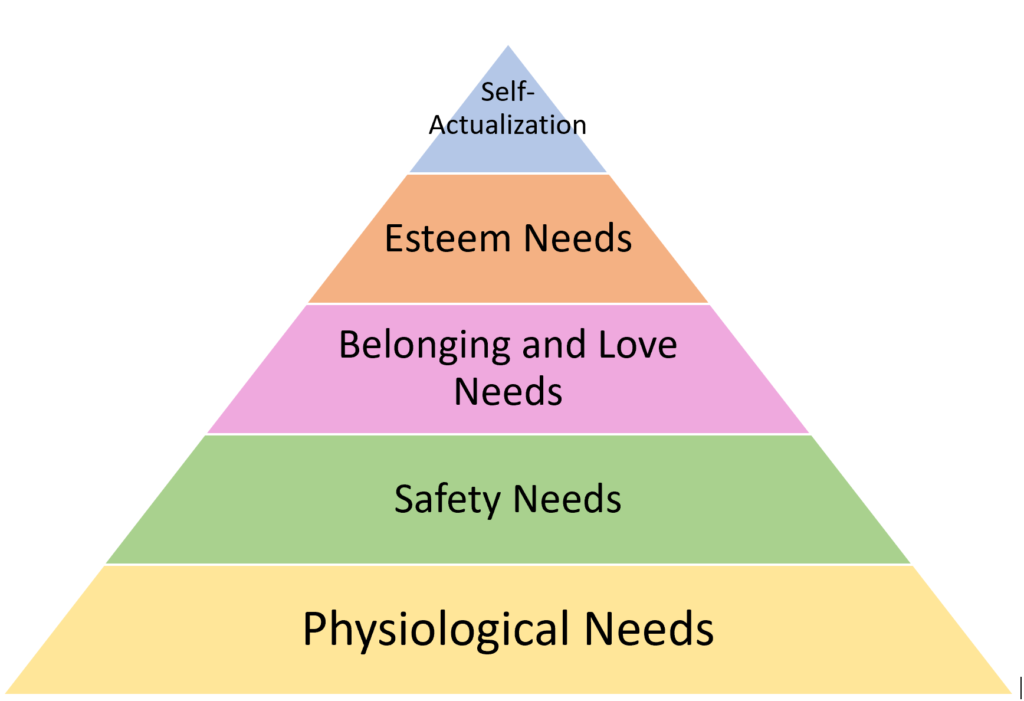The title of my blog is Nursing Priorities but I have yet to address this topic for nursing students. In this post, I will explain what I feel are the basics of setting priorities. Safe decisions in nursing show an understanding of appropriate prioritization. These decisions are also the focus of nursing questions in on nursing exams. You will also see examples in clinical and on the NLCEX.
Determining Patient Needs
The basis for prioritization in healthcare is Maslow’s hierarchy of needs. I’ll bet you are familiar with the triangular diagram below. Psychology courses and nursing fundamentals courses include a discussion of Maslow’s theory. This theory of human behavior was first published by Abraham Maslow in 1943. It explains the intrinsic needs we all have.
The needs that are the most basic are at the bottom of the diagram. Once those needs are met, we can move up to the next level. The top needs can only be addressed if those below them are met. Of course, there is some overlap between levels. But, when looking at what needs to meet, the nurse must focus on those lower in the hierarchy first.

Maslow’s Hierarchy of Needs
Here is a list of what needs are atin each level, from bottom to top:
- Physiological Needs: The basic needs must be met to ensure physiological integrity. They include air, water, food, appropriate temperature, shelter, and rest. Nurses must prioritize these life-threatening issues or risks first when providing care. So, issues with breathing, hydration, nutrition, thermoregulation, or sleep are the highest priorities.
- Safety Needs: The next level’s needs include safety and security. These are problems or risks related to the environment, security, and fear. Examples would be falls or fall risk, other environmental hazards, abuse or violence, or lack of security (physical, medical, financial, etc.).
- Belonging and Love Need: This level involves social needs. We all need a sense of belonging to a family or group. We strive to love and to be loved. Issues at this level include isolation, loss of friendship or social support, and lack of intimacy.
- Esteem Needs: Needs at this level include the need for self-esteem. They also include a feeling of self-worth, dignity, and respect. If a person doesn’t feel respected or in control of their situation, they may have a loss of esteem.
- Self-Actualization: After meeting all other needs, the person may pursue the need for self-actualization. These needs include a feeling of personal growth, advancement, and self-fulfillment. Issues threatening personal goals may alter the feeling of self-actualization.
Nurses have a complicated role. There are often many options for care availabe. But, some decisions are more important than others. Choices to prevent or deal with a life-or-death issue are the highest priority. Many nursing instructors will discuss the “ABC’s.” This stands for for airway, breathing and circulation. These are the physiological needs that must take priority over others.

What to Watch for on Exams
In an exam setting, watch for terms with priority attached in the stem of the question. Also watch for questions like “Which patient should be seen first?” “Which change is most significant?” or “What should the nurse implement?” Each of these questions require analysis to determine the priority change or action.

NCLEX-Style Questions regarding Prioritization
Here is a sample NCLEX-style question.
A nurse is preparing to care for four patients on a medical-surgical unit. After the handoff, which patient is the highest priority? (In other words, which patient must be seen first?)
- A patient who is 1-day post-appendectomy who is preparing for discharge in 2 hours.
- The patient with a chest tube and is complaining of chest pain and shortness of breath.
- The patient post-mastectomy who is weepy and asks for information about wound care.
- The patient treated for heart failure with a furosemide infusion at 5 mg/hr.
These are all patients who need the nurse’s care. However, the priority patient is the patient experiencing shortness of breath. The chest tube may not be functioning correctly or may have been dislodged. If a patient has a chest tube, the usual reason is to prevent or treat a pneumothorax. If the tube is working properly, the patient shouldn’t experience shortness of breath. Without more information, the nurse must opt to see this patient first. The patient with heart failure is not described as having any urgent symptoms. The post-mastectomy patient certainly needs support and education. But the ABCs do not appear threatened. The nurse will have to assist with discharge teaching for the appendectomy patient. There is time to proceed without indication of a complication.

In the Clinical Experience
While in the clinical experience, the nursing student must listen in handoff. Note any issues with the assigned patients. Consider if there would be any life-threatening risks are discussed in the handoff. If not, consider safety risks. Prioritize the order of care to be provided based on any problems or risks identified. Discuss your plan with your supervising RN or instructor. Be alert to sudden changes that could develop with any patient. As a nursing instructor, I have had students come to me saying, “My patient is struggling to breathe. This wasn’t reported to me.” Or “Yesterday my patient was alert and oriented but he seems confused today.” These kinds of changes indicate worsening. Immediate intervention is required. Reporting changes to the nurse and/or your instructor are priorities.

Prioritization is a Skill
Prioritization is an important skill in nursing. Emphasis is placed on this component of clinical decision-making both in school and in practice. The skill may be an unclear concept. But, the ability to prioritize must be accomplished. Nurses who struggle with priorities risk the health and safety of their patients. In education and in practice, time spent learning how to prioritize is necessary. Nurse educators and preceptors realize the importance and focus on the skill. Only through thoughtful reflection and practice can the nurse become skilled in prioritization. Learning this skill is a nursing priority!
Do you need more resources? Here are a few related blog posts to help:
Nursing.com: Provide the Best Nursing Care (Nursing Prioritization)
Straight A Nursing: How to Prioritize Patient Care
Simple Nursing (by Mike Linares): Fundamentals of Nursing: Client Prioritization, Part 1
Reference:
Maslow, A. H. (1943). A theory of human motivation. Psychological Review, 50(4), 370–396. https://doi.org/10.1037/h0054346

